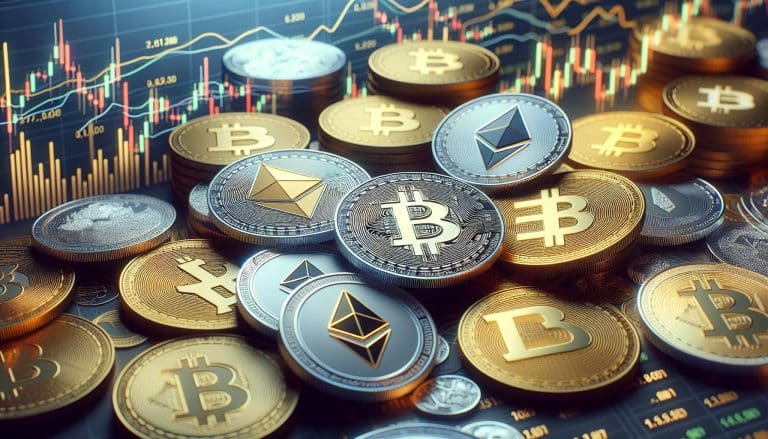The Worst Times to Buy Altcoins: Smart Strategies for Savvy Investors
Navigating the world of altcoins can be tricky and knowing when to buy can significantly impact your investment returns.
Avoid buying altcoins during market hype periods or when there’s high volatility, as these times are often when prices are inflated.
Instead, focus on strategies that provide long-term value and minimize risk.
Understanding the cyclical nature of the altcoin market can help you make smarter decisions.
It’s important to recognize the signs of an overhyped altcoin. These typically include sudden price surges backed by little to no substantial news or developments.
Staying informed about market sentiment and regulatory changes is key to spotting these trends before they lead to costly investments.
Exploring alternatives like staking or earning can offer attractive returns without the immediate risks of buying at the wrong time.
By paying attention to seasonal trends and key market indicators, you can better position yourself to either enter or exit the market effectively.
Remember, a balanced approach can help protect your investments and yield better outcomes over time.
Key Takeaways
- Avoid buying during market hypes and high volatility.
- Recognize signs of overhyped altcoins to make smarter choices.
- Consider alternatives like staking and watch market indicators.
Understanding the Altcoin Market Cycle
The altcoin market cycle consists of periods of growth and decline. Knowing these phases can help you make better decisions when trading or investing in altcoins.
The cycle typically follows a sequence of accumulation, expansion, distribution, and contraction.
Key Phases
-
Accumulation Phase
During this phase, prices are relatively stable. This period is marked by low trading volumes as investors, often called “smart money,” begin to buy altcoins quietly. -
Expansion Phase
Here, altcoin prices start rising significantly. This phase sees increased interest and higher trading volumes. Investors feel optimistic, and new participants often enter the market. -
Distribution Phase
Altcoin prices peak during this phase. Early investors begin selling their holdings to take profits. Market sentiment may remain positive, but signs of selling pressure begin to show. -
Contraction Phase
This is when prices decline from their highs. The market may experience panic selling, resulting in a rapid drop in prices. This phase presents high risk for uninformed investors.
Considerations
It’s important to utilize tools like the Altcoin Season Index to evaluate market trends.
Knowing whether you are approaching an expansion or contraction phase can guide your investment strategies.
Research and Awareness
Being aware of current market conditions and news can provide insights into which part of the cycle the market is in.
Stay updated with platforms like Crypto News for reliable information.
Identifying Overhyped Altcoins
Spotting overhyped altcoins can be tricky but knowing the signs helps you make informed decisions. Here are some red flags to watch for:
-
Excessive Media Buzz: If an altcoin is repeatedly mentioned in media with promises of huge returns, it might be overhyped.
-
Price Spikes: Sudden price increases with no clear reason can be a sign of artificial inflation.
-
Lack of Clear Use Case: If a coin doesn’t have a practical purpose or solves no real problem, question its long-term value.
-
Shallow Whitepapers: Well-crafted whitepapers are crucial. If a whitepaper lacks depth or detail, proceed with caution.
Social media plays a big role in driving hype. Be wary of communities that are overly aggressive or too positive without critical analysis.
Check investor reviews and discussions on platforms like Reddit. This helps you gauge true sentiment.
Finally, compare altcoins’ performance to Bitcoin. Often, altcoins lag behind during Bitcoin rallies, revealing underlying weaknesses.
Typical Triggers for Poor Buying Times
One major trigger for poor buying times is market hype. When everyone is talking about a specific altcoin and media attention is high, prices can become inflated. Buying during this hype often leads to paying more than the coin’s actual value.
Another signal is high Bitcoin dominance. When Bitcoin’s market control increases, altcoins usually decrease in value. This signifies a bearish period for altcoins as investors flock to Bitcoin for safer bets.
Beware of regulatory news. Announcements of potential regulations or legal issues often result in price drops. Such news can cause panic selling, leading to a decrease in altcoin value.
Technical indicators also play a role. If the market shows a price pattern like a head-and-shoulders, it indicates potential downturns. Knowing these patterns can help you avoid bad buying times.
Past performance is not always an indicator of future growth. If an altcoin had a major price surge recently, it might be risky to buy. Prices sometimes retract to more stable levels, meaning you might end up paying a premium.
Consider these typical triggers to better time your altcoin purchases. Being aware of these factors can help you make more informed investment decisions.
The Impact of Regulatory News on Altcoin Prices
Regulatory news can significantly affect altcoin prices. When governments or financial authorities discuss new crypto regulations, it often leads to market volatility.
If regulations seem strict, prices might drop. On the other hand, supportive regulations can boost prices. Market reactions are usually swift, so staying informed is key.
Key Factors to Watch:
-
Announcements: New rules or guidelines on cryptocurrencies can cause immediate price swings.
-
Meetings: High-profile meetings with regulators and crypto leaders can signal future changes.
-
Global Impact: Regulations in major markets like the U.S., Europe, or China can ripple through global markets.
You should also pay attention to recommendations from international organizations. Bodies like the International Organization of Securities Commissions often provide insights into how regulations might impact digital currencies. These updates can provide clues about future trends.
Use tools and apps that provide real-time alerts on regulatory news. Quick reactions can help you make informed decisions before the market fully reacts. By understanding and anticipating these changes, you can better navigate the impacts on altcoin prices.
Alternatives to Buying: Altcoin Staking and Earning
If you’re looking for ways to benefit from altcoins without directly buying them, consider altcoin staking and earning through various platforms.
Altcoin Staking: Staking involves holding a certain amount of your altcoins in a wallet to support the operations of a blockchain network. In return, you receive rewards in the form of additional coins. This can be a good way to increase your holdings without spending more money.
Some popular altcoins for staking include Ethereum, Cardano, and Solana. These coins offer different reward rates and requirements, so it’s important to research which ones suit your goals.
Besides staking, another option is earning through altcoin exchanges. Platforms like Huobi allow users to earn by participating in different activities such as lending or liquidity mining. These methods can offer a steady income stream while maintaining control over your assets.
When choosing an exchange or platform, ensure it is reputable and secure to protect your investments. Some exchanges even provide insurance against losses.
Here’s a quick look at some exchanges for earning:
| Exchange | Features |
|---|---|
| Huobi | Large selection of coins, secure |
| Binance | Various earning options, user-friendly |
| Kraken | Reliable, solid staking options |
Staking and earning are excellent strategies if you want your existing altcoin holdings to work for you. They require proper research and understanding of the risks involved, so be sure to explore these options fully before committing.
Market Analysis Techniques to Avoid Bad Purchases
Investing in altcoins can be risky, but using market analysis techniques helps you avoid bad purchases.
1. Stay Informed: Regularly read articles, check news, and follow updates about your chosen altcoin. Websites like Cointribune offer comprehensive guides to help you understand market conditions.
2. Technical Analysis: Use charts to track price movements and trends. Look for patterns that indicate potential price drops or spikes, helping you make more informed decisions.
3. Fundamental Analysis: Evaluate an altcoin’s underlying value. Consider the technology behind it, its use case, and the team involved. Medium offers tips on conducting a thorough fundamental analysis.
4. Sentiment Analysis: Gauge public perception by looking at social media, forums, and online discussions. A positive sentiment might suggest increasing demand, while negative sentiment could indicate caution.
5. Diversify: Don’t put all your resources into one altcoin. By spreading your investments across multiple coins, you reduce the risk associated with a single asset.
Using a combination of these techniques helps build a robust strategy, increasing the chances of smarter investments and reducing the likelihood of making poor purchasing decisions.
Seasonal Trends and Altcoin Valuation Peaks
Understanding when to invest in altcoins can be just as important as knowing which ones to choose. Seasonal trends often influence the valuation of altcoins.
Altcoin season, or “altseason,” occurs when altcoins experience a surge in prices compared to Bitcoin. Typically, this happens after Bitcoin has had a strong performance period.
During altseason, you’ll notice that many altcoins outperform Bitcoin. It can be tempting to buy during this rise, but prices can be inflated. Observing patterns like this helps in making more informed decisions.
One indicator useful for identifying altseason is the Altcoin Season Index. This index measures altcoin performance against Bitcoin. A high score suggests strong altcoin activity.
Prices of altcoins often peak during the altseason. It is wise to consider waiting for prices to stabilize before purchasing. Buying during a dip can provide better entry points.
Example of Seasonal Trends:
| Quarter | Market Trend |
|---|---|
| Q1 | Slow growth |
| Q2 | Possible altseason |
| Q3 | Stabilization period |
| Q4 | End of year spike |
These trends are not set in stone, but they offer guidance on market behavior. Watching these patterns can help you avoid overpaying during peak periods.
Keeping an eye on market news, technical analysis, and seasonal patterns can assist in timing your altcoin purchases more effectively. This strategic approach benefits long-term investment plans.
Key Indicators of an Impending Bear Market
Recognizing the signs of a bear market can help you make better investment decisions.
Understanding these indicators is a valuable skill.
One key indicator is euphoric investor sentiment, where extreme optimism might signal a downturn.
When everyone is buying, consider it a warning sign.
Another warning sign is when major stock indices start declining by 20% or more.
Pay attention to bear market indicators, like these, which can suggest negative trends.
Economic factors such as rising unemployment rates or declining GDP growth can also indicate trouble.
When the economy struggles, markets often follow suit.
Keep an eye on inverted yield curves. This occurs when long-term interest rates fall below short-term rates, and it’s an often-discussed predictor of economic troubles.
Monitoring corporate earnings is crucial. When companies report declining profits for consecutive quarters, it may signal a market downturn.
Look at institutional investors. If they start selling heavily, it’s a red flag.
Institutions often have more research at their disposal.
Caution is advised when you notice significant increases in market volatility. Puffiness in market prices can indicate underlying instability.
Avoid making snap decisions based on only one indicator.
Instead, consider a combination of factors to assess market conditions comprehensively.
Staying informed can help you navigate the financial landscape effectively.
Always be cautious and evaluate your investment strategy regularly.
Strategies for Portfolio Diversification
One effective way to diversify your crypto portfolio is by investing in cryptocurrencies with different purposes.
This can include coins used for transactions, decentralized applications, or privacy protection. Each type of cryptocurrency has unique characteristics and uses.
Portfolio Allocation Tips:
-
Conservative Portfolio:
- 60% Bitcoin
- 30% Stablecoins
- 10% Altcoins
-
Balanced Portfolio:
- 40% Bitcoin
- 40% Altcoins
- 20% Stablecoins
You can reduce risk by spreading investments among various crypto assets.
This strategy helps in limiting exposure to any single asset type.
Diversifying across different market caps can also be beneficial. You might mix large-cap, mid-cap, and small-cap cryptos.
Large-cap cryptocurrencies are generally more stable, while small-caps can offer higher growth potential but with increased risk.
Investing in international projects can open up new opportunities. By adding global projects, you gain exposure to various regional markets.
Research is key to successful diversification.
Familiarize yourself with the crypto market and keep track of emerging trends.
Staying informed can help you make better investment choices.
By following these strategies, you can create a diversified and resilient portfolio that suits your financial goals.
When to Consider Converting Altcoins to Stablecoins
There are times when converting altcoins to stablecoins can be a strategic move. Understanding the market’s movements is crucial.
High Volatility:
Altcoins can have drastic fluctuations in value due to speculation. If you notice high volatility, moving to stablecoins might help protect your investment.
Economic Uncertainty:
During uncertain economic periods, stablecoins can offer a safer option. They maintain a stable value, unlike altcoins, which can be more unpredictable.
Market Trends:
Stay updated with market trends. In an altcoin season, many altcoins might outperform Bitcoin, but trends can reverse quickly.
Avoiding Losses:
If your altcoin holdings start losing value, converting to stablecoins can preserve some capital. Stablecoins are designed to resist such losses with their stability.
Waiting for Better Opportunities:
Holding stablecoins can help you wait for better investment opportunities. This strategy allows you to re-enter the altcoin market when conditions are more favorable.
Portfolio Balance:
Regularly review your portfolio. If too much is in volatile assets, shifting some altcoins to stablecoins can bring balance and reduce overall risk.
Long-term Investment Mindset vs Short-term Trading
When you think about investing in altcoins, it’s important to decide whether you’re aiming for a long-term approach or short-term trading.
- Duration: This means holding assets for a year or more.
- Risk and Return: Long-term investments often deal with more risk but can lead to higher returns. They are generally less affected by short-term market changes.
- Strategy: This involves patience, as you’re willing to wait for the market to grow over years.
- Duration: In this style, assets are usually held for a year or less.
- Risk and Volatility: Short-term trading can be more volatile, meaning there are chances for quick losses or gains.
- Strategy: It requires quick decisions and active monitoring as it takes advantage of short-term market trends.
Comparison
| Aspect | Long-term Investing | Short-term Trading |
|---|---|---|
| Holding Period | Over a year | Less than a year |
| Risk | Lower daily risk | Higher daily risk |
| Flexibility | Less flexible | More flexible |
| Time Commitment | Lower day-to-day | Higher day-to-day |
Understanding these differences can help you align your investment with your goals and risk tolerance.
Adjust your decisions based on how much time you can dedicate and how much risk you are willing to take.
Are there certain events or announcements that typically lead to a decline in altcoin prices?
Regulatory news or hacks can trigger a decline in altcoin prices. These events often cause panic selling among investors, which can drive prices down rapidly.





